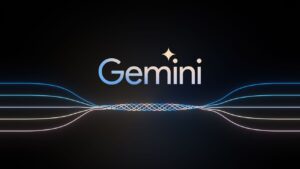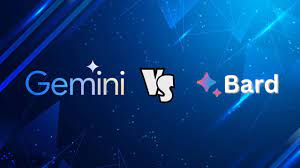Google Bard vs. Google Gemini: Understanding the Differences. In the rapidly evolving landscape of AI technologies, Google has introduced two powerful models: Bard and Gemini. While both serve as advanced AI tools, they have distinct functionalities and target different user needs. Here’s an in-depth look at the key differences between Google Bard and Google Gemini so you can know which one to use for which purpose.
Core Functionality of Bard vs Gemini
Google Bard:

Bard is primarily a conversational AI chatbot designed to engage users in interactive dialogues. It excels in generating creative content such as stories, poems, and detailed text responses. Bard is intended for direct consumer use, making it accessible and user-friendly for everyday tasks like writing, answering questions, and providing recommendations.
Google Gemini:

Gemini, on the other hand, is a multimodal AI platform capable of understanding and generating not just text, but also images, videos, and audio. It is designed to handle a wide range of tasks, including coding, content creation, and complex problem-solving. Gemini’s capabilities extend beyond simple text generation, making it suitable for applications in software development, research, and multimedia content creation.
Technological Foundation
Google Bard:
Bard was initially based on Google’s PaLM large language model but has since been upgraded to incorporate elements of the Gemini model. This enhancement has improved Bard’s generative and problem-solving capabilities. However, Bard remains focused on text-based interactions and creative tasks.
Google Gemini:
Gemini is built using Google’s latest AI technologies, including Tensor Processing Units (TPUs) optimized for machine learning tasks. It leverages extensive datasets from the internet and other sources to train its models. Gemini’s multimodal approach allows it to process and generate content across different formats, making it a versatile tool for diverse applications.
Usage Scenarios
Google Bard:
Bard is tailored for users seeking a conversational AI that can assist with everyday creative and informational tasks. It is ideal for writing assistance, brainstorming ideas, and engaging in natural language conversations. Bard’s ease of use makes it suitable for general consumers who do not require technical expertise.
Google Gemini:
Gemini’s strength lies in its multimodal capabilities, making it suitable for more complex and varied applications. It can be used for software development, where it excels in code generation and debugging. Additionally, Gemini’s ability to handle images, audio, and video makes it a powerful tool for content creators, researchers, and professionals who need a comprehensive AI solution.
Special Features and Integrations
Google Bard:
Bard offers several features designed to enhance user interaction, such as multilingual support and the ability to generate diverse text formats. It integrates with Google’s ecosystem, providing real-time web access and extensions through plugins, which expand its capabilities.
Google Gemini:
Gemini is available in different versions, including Ultra, Pro, and Nano, each tailored for specific use cases. For example, Gemini Nano is optimized for mobile devices, while Gemini Pro and Ultra handle more complex tasks like scientific research and advanced coding. Gemini’s integration into applications like Samsung Notes and its availability through Google Cloud’s Vertex AI platform highlight its versatility and scalability.
Strengths and Limitations
Google Bard:
Bard excels in generating human-like conversations and creative text content. However, it can exhibit biases and inaccuracies, and its creative output may sometimes lack originality. Bard’s reliance on existing data sources can lead to repetitive or incorrect information.
Google Gemini:
Gemini stands out for its multimodal proficiency, advanced reasoning, and robust performance in complex tasks. It has demonstrated superior capabilities in areas like Massive Multitask Language Understanding (MMLU). However, its complexity and advanced features mean it has a steeper learning curve and may not be as accessible to non-technical users.
Pricing and Accessibility
Google Bard:
Bard is available with a basic free tier, with premium options that offer additional features and higher usage limits. This makes Bard accessible to a broad audience, from casual users to professionals seeking more advanced capabilities.
Google Gemini:
Gemini’s pricing varies based on the version and usage. The basic API access is free, with limitations on the number of queries. More advanced features, such as those offered by Gemini Pro and Ultra, come with a cost, reflecting their enhanced capabilities and intended professional use.
Bard vs Gemini? It depends on the task
Google Bard and Google Gemini serve different purposes within the AI ecosystem. Bard is designed for engaging, creative conversations and general consumer use, while Gemini offers a more comprehensive, multimodal AI experience suitable for professional and technical applications. Understanding these differences can help users choose the right tool for their specific needs, whether it’s for creative writing, complex problem-solving, or multimedia content creation.
What to read next?
- How to make your Morning Routine Successful
- Top 7 Instant Pots: Understanding the Many Different Models and Choosing the Right One for You
- ChatGPT FAQs, Troubleshooting, Advanced Features, and Practical Applications
- Understanding ChatGPT vs GPT-4 vs DALL-E – When do you use which one?
- 10 Tips for using ChatGPT + a detailed example of how a student can use ChatGPT for school projects.
- Ashwagandha Mental Health Benefits for teens and adults.
- 3 Fish Taco Recipes: Baja-style, Chipotle, and Blackened. Which is your fav?
- Google Bard vs ChatGPT – which one is best?
- The 5 Best Sous Vide Machines
- Traeger Flatrock Grill vs Blackstone Griddle

